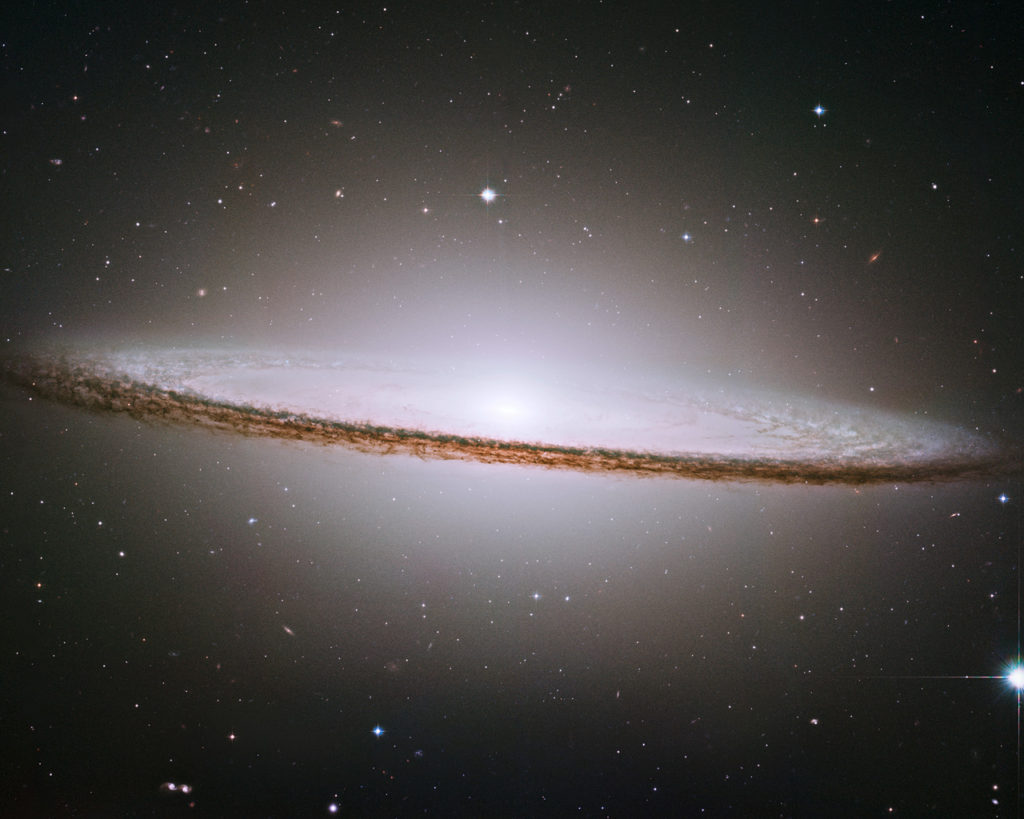
Pierre Méchain (1744-1804) first described the Sombrero Galaxy in 1781, but it was not formally added to the Messier Catalogue until 140 years later in 1921. William Herschel (1738-1822) and Charles Messier (1730-1817) were also among the first astronomers to describe it. Messier had written a note about the Galaxy and five other objects that he intended to add the list of astronomical objects now called the Messier Catalogue. The French astronomer Camille Flammarion (1842 – 1925) found Messier’s hand-written notes about his later finds, including the Sombrero Galaxy, and added them to the Messier Catalogue. In keeping with the Catalogue’s format, the Sombrero Galaxy was dubbed M104.

Sombrero Galaxy Profile
Designation: NGC 4594 or M104
Type: Spiral
Constellation: Virgo
Distance: 29 Mly
Diameter: 50,000 ly
Mass: 800 billion M☉;☉ = the mass of the sun
When it was discovered: 1781
Estimated number of stars: Several hundred billion
Fascinating Facts About the Sombrero Galaxy
• The Sombrero Galaxy has a supermassive black hole in its center. The patterns of star movements near the black hole suggest that it could have the same mass as a billion of our suns. Researchers believe that the Sombrero’s black hole is the most massive of any that has been found at the heart of a galaxy.
• Astronomers don’t believe that the Sombrero Galaxy is the part of any formal galaxy group. Instead, it seems to be part of a string of galaxies that extend away from Virgo.
• The Sombrero Galaxy is about 3/10 the size of the Milky Way Galaxy.
• Vartox is a minor character from the Superman comics; he is described as hailing from the planet Valeron in the “Sombrero Hat” Galaxy.
• The Sombrero Galaxy has an apparent magnitude (brightness) of around 9.0 and can therefore be easily seen with ordinary telescopes.
• On a dark night, people can even see the Sombrero Galaxy through ordinary binoculars. It can be seen during the spring and early summer between the constellations Corvus and Virgo.
• There may be up to 2,000 globular clusters in the galaxy’s core, which is about ten times the number of clusters in the Milky Way Galaxy.
• As with the Milky Way, the Sombrero’s globular clusters are thought to be between ten and thirteen billion years old.
• NASA has used both the Spitzer Space Telescope and the Hubble Space Telescope to study the Sombrero in infrared and visible light.
• Researchers estimate that the Sombrero Galaxy has at least one hundred stars for every human on Earth, and there are over seven billion people.
• In 1912, an American astronomer named Vesto Slipher, who was working at the Lowell Observatory, noted that the Sombrero Galaxy had a very large red shift that proved the Sombrero was very distant and outside the Milky Way. Before Slipher’s discovery, astronomers had thought the Sombrero was a spiral nebula within the Milky Way.
• Slipher also determined the Sombrero Galaxy was moving away from us. He was thus one of the first people to prove that the universe is expanding.
• The Sombrero’s dust lane, which reminds observers of the hat’s broad rim, is made up chiefly of hydrogen gas and dust. It contains most of the molecular cold gas in the galaxy and is the chief site of star formation.
• By contrast, researchers believe that not many stars form within the galaxy’s nucleus.
• The original 1960s version of the TV series “The Outer Limits” included pictures of the Sombrero Galaxy in the end credits.
• The Sombrero Galaxy has traits of both spiral and elliptical galaxies. It looks like an elliptical galaxy that somehow swallowed a spiral galaxy – but scientists believe that to be impossible. Such an event would have caused the destruction of the spiral galaxy.
• Instead, scientists speculate that a large elliptical galaxy accumulate lots of gas clouds around nine billion years ago, and those gas clouds eventually flattened out into the shape of a spiral galaxy.